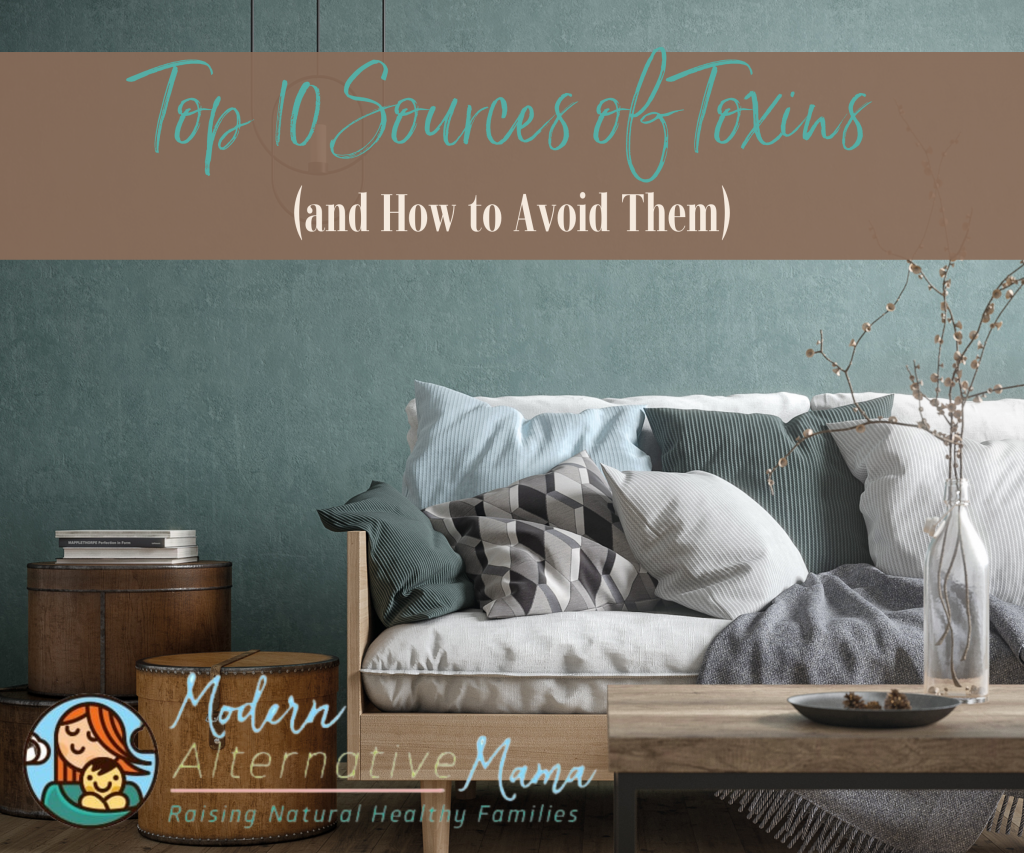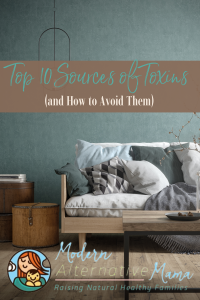By Danielle, Janine and Rustina, Contributing Writers
We all try our best to avoid toxic things, but toxins are seemingly everywhere in our environment — both inside and out! Once you are aware of where toxins hide you can make choices to help reduce your contact with them where it makes sense for you.
Top 10 Sources of Toxins
1. Clothes
If you’re an avid shopper you should be aware that new clothes contain toxins from the manufacturing process. Many clothing items are produced in foreign countries, such as China, where their manufacturing laws are less strict which means they use more chemicals in their processing. Most of our clothes are made from oil-based plastic substances, not to mention flame retardants that are mandated to be on certain items or tagged with a warning. Avoid this by purchasing organic cotton, wool, hemp, linen, or other natural substances.
Chemicals used in the manufacturing process include (1):
- Flame retardants – linked to many health risks, including infertility, neurotoxicity, endocrine disruption, and cancer.
- PFAS (Polyfluorinated Substances) are often used for water “resistance” in shoes, cosmetics, mattress pads, and other things labeled water or stain-repellent. These are referred to as “Forever Chemicals” and can be carcinogenic.
- Phthalates are used in activewear, anti-odor clothing, and in the print material on clothing. They have been linked to endocrine disruption and cancer.
- AZO dyes. These colorants can cause allergies and dermatitis, as well as be linked to cancer.
- Many solvents, adhesives, and other chemicals/fibers can release VOCs (volatile organic compounds) that are released in the air as gasses that we breathe in.
These chemicals are not only on your clothes, but also get released into the environment through lakes and streams. This poisons the environment surrounding the processing plants and has disastrous effects on wildlife and people.
When buying new clothing, be sure to wash it a couple of times before wearing it to wash off some of the chemical residues.
2. Food
I know I don’t need to delve into the toxins in our food that much, we know about them by now.
Pesticides and preservatives fill our food, not to mention genetically modified organisms (GMOs). Even natural and organic foods can be processed and filled with preservatives.
It’s best to avoid the interior, boxed aisles of the store, and instead, head to the outer edges of grocery stores for fresh produce (check out the 2023 Dirty Dozen list), meats, dairy, and whole grains. Better yet, find a local regenerative farmer and get a veggie CSA, fresh greens, microgreens, and even volunteer your time for a biome boost of good bacteria (from the soil!).
Pesticides and herbicides are widely used on crops throughout the world. These chemicals remain in the environment forever and do not break down. We can become exposed to them when they are being sprayed onto crops, or when we eat foods that have been sprayed with them.
Pesticides and herbicides also contribute to air pollution alongside other environmental toxins.
Outside of our food , our medicine has become toxic. Medicine should gently aid the body to heal, not add further toxins to cover symptoms for the short term. Unfortunately, that’s what our medical system has become. Often, side effects are worse than the actual illness.
Most of us are most concerned with the toxins in our food, but unfortunately, they do not stop there.
Boxed foods from grocery stores contain additives to make them last longer. These additives aren’t created in nature and are harmful to our health. You can learn more about food additives in our Understanding Food Toxins post. Other additives found in food include food dyes. These have been found to cause behavior problems in people, especially Yellow 5, Yellow 6, Blue 1, and Red 40. Learn about Why You Should Ban Food Coloring in Your Home.
3. Water
Water is supposed to be a pure substance that hydrates us, but sadly it contains many chemicals. Cities add fluoride and bleach to the water system in questionable quantities, while country wells may contain high nitrates from pesticides. It’s best to find a water filter for your home, or at least your drinking water. Avoid city water altogether if your city adds non-NSF bleach.
Chemicals get into our water in these ways:
- Manufacturing processing.
- City treatment facilities.
- Agricultural runoff.
- Illegal dumping.
- Radioactive wastes from power plants.
It’s important that we source quality water from clean sources. There are many treatment units you can purchase for your home. If those are out of your price range you can buy high-quality, ethically sourced, water from a fresh spring source that doesn’t have any major polluters nearby. Make sure you research where the water company sources their water before trusting the label on the front. Not all bottled waters are made equally!
Learn more at Everything You Need To Know About Water Filters.
4. Air
Air pollution can negatively affect our health by causing breathing problems like asthma, as well as other problems. Pollution is created by pretty much every human activity on earth. But the most notable contributors are vehicle exhaust, oil refining processes, and manufacturing processes.
Even though there is little fresh air still available, it’s important to get out into the air as much as possible. If you don’t have a lot of property, or live near a road or highway, find a local park or forest to go frequently to breathe in fresh air. Did you know that your lungs can actually assimilate nutrients, like your gut? They can! Breathe in those essentials – but try your best to make sure the air is clean!
Some people are so affected by air pollution that they cannot go out on days where the pollution is at its worst. Between car exhaust, chemtrails, and pollutants, our air is also rather toxic. Indoor air can sometimes be just as bad or worse!
Indoors, get a HEPA air filter if you live in a stuffy house, apartment, or in the city. Open your windows often, especially for 15-20 minutes during warmer winter days, and in the hot summer when you run air conditioning constantly. Learn more at Everything You Need To Know About Air Filters.
5. Home
We always think of our home as a safe place to rest our heads and feet after a long day. But there can be toxins in our home that can be contributing negatively to our health. Mold is the most common household toxin in many homes. Mold can go undetected, hidden under carpets, behind cabinets or wallpaper, or stashed in the attic.
Mold sickness is very real and can cause a whole host of health issues. The only solution for people who are greatly affected is to move away from the source. Mold remediation companies can also come to properly remove it. You should never try to remove mold yourself since this can spread it throughout the home.
Cleaning products used to clean our homes also contribute to indoor pollution. Using natural alternatives can help to reduce indoor air pollution. Check out our safe and natural cleaning products and Clean Home Project Guide. We can clean well without dangerous and harmful chemicals!
Our homes are built with chemically-treated wood, paints which are toxic to breathe, and sealed with chemical finishes. Laminate floors and carpets carry their own toxins. Consider using natural materials for building, such as straw clay walls, wool insulation, ceramic floors, or natural wood floors with walnut oil stain.
6. Body Products
Our skin is considered our largest organ and it’s also the most absorbent. This can be a problem when you use skincare and body products that contain harmful ingredients like fragrances, because your body will readily absorb those ingredients.
Choosing skin care products made from natural ingredients can go a long way to reducing your exposure to the toxins found in these products. You can read about our products at Earthley in our Skin Care Guide.
7. Toys
With so many toys coming from all over the world or made very cheaply in the US, things like lead in the paint or surprise choking hazards are not out of the question even today! Even toy jewelry has been found to have lead! If you are buying gifts for kiddos, check out our recommendations in The MAM Holiday Gift Giving and DIY Guide for the Naturally Minded and our 10 Non-Candy Easter Basket Ideas (both have great anytime options).
8. Food Storage Containers
Traditional plastic food storage containers contain many harmful toxins like BPA and BPS (the sneaky chemical they thought they would try to replace BPA with but which is just as harmful), as well as lead, phthalates, and PVC. All of these additives are toxic, and especially when the containers are heated or hot food is placed into them.
Swap plastic dishes out for glass, stainless steel, ceramic (lead free), and wood. We recently purchased wood plates and utensils on Etsy, and love them! Toss out nonstick cookware and instead use stainless steel pots and pans, glass casserole dishes, ceramic baking sheets, and cast iron.
9. Your Car
Do you have a new car? You know that smell, that new car smell? You’re pretty much just breathing in a toxic soup of brominated flame retardants (BFRs), chromium, and lead. These things are used in the manufacturing process of your car’s interior.
Some people will park their new car in their garage and leave the windows open for a period of time to let the car off-gas for a while. Although, this could contribute to poor indoor air quality in your home if the off-gassing gets into your house.
While you check out Air Filters for your house, check out this air purifier for your car also!
10. Stress
Stress can create an internal environment that is toxic. It does this by altering your gut bacteria negatively. This change is gut bacteria can change everything from how you digest food to how your mind works. Stress can also use up vital nutrients that your body needs to detoxify from other environmental toxins you might encounter.
Check out Earthley’s Stress and Sleep products to keep your stress in check and improve your sleep quality. We also have a blog post, Natural Remedies for Anxiety.
Keep the Stress Down by Detoxing
It’s easy to feel discouraged about the toxins in our modern world. Cut out what toxins you can, and chip at the others one by one – being content with what you have accomplished. Flushing your body of inevitable toxins should also be on your frequent to do, and doesn’t have to cost a lot.
Here are a few easy detox tips:
- Consistently detox with Epsom salt/bentonite clay baths, Herbal Detox Baths, and Herbal Tinctures like Vaccine Detox.
- Be sure to be eating whole, real foods, and use herbal infusions, teas and tinctures to get your vitamins and minerals in a bioavailable way.
- Check out our Vaccine Detox Protocol and Immunity Tool Guide for more tips on healthy, safe, and gentle detoxing!
Disclaimer: This post is not intended as medical advice. These statements have not been evaluated by the FDA, and nothing in this post is intended to diagnose, treat, or cure anything. If you have questions, please do your own research or seek advice from a health professional.







